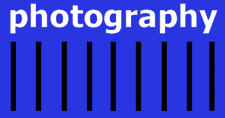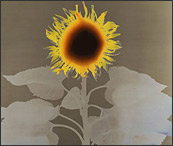

1) Photograms
This is a good project to start with because it doesn’t
require the camera or film, so while they’re working on shooting and
developing their first actual shooting project (”Making The Familiar
Unfamiliar”), you can familiarize them with the darkroom and they can
be learning how to print. Breaking the class up into groups is a good idea;
those developing film, and the others in the darkroom. It’s also a good
idea to first bring an enlarger out into the lit classroom to explain the
different parts. Photograms introduce them to the ways that light works with
the enlarger, to how the photographic paper works, and to the steps involved
in developing the print. All without needing negatives. Visually it helps
with abstraction. Have them bring in their own objects to use for a composition,
with some allowing for varying degrees of transparency.
2) Making the Familiar Unfamiliar
This is an excellent concept for a first shooting
project. It aims to compel students to see in terms of abstraction. It helps
them to see the world around them through a different “lense”-
to see things anew. It pulls them away from narrative expectations. In doing
so it helps them to approach photography as an art form and empowers them
to form images, rather than to merely record them. The frame becomes all important-
help them to focus on deliberate composition; this goal is an effective predecessor
to introducing ideas of meaning and signification: what things mean, and what
images mean when "things" are juxtaposed within a frame.
These are the “tips” I include on the handout:
- get rid of extraneous details... nothing should be in the frame that you
don’t want to be.
- transform what you see by using the camera... the resulting photograph should
give the viewer a new
way of seeing something that they thought they were already familiar with.
- find different ways to do this in each shot: angle of view, proximity to
your subject, lighting, etc.
3) List Project
This has been a favourite amongst my students because
it allows them to go in so many different directions and really get a feel
for the medium. I’ve tailored it for advanced students as well. The
idea is to provide them with a list of images and have them shoot 2 to 3 rolls
to cover at least 12 out of the 16 images listed, with 6 final prints turned
in. As you can see from the list, conceptual and technical demands are being
placed on them. By now they should’ve been taught and shown examples
of what manipulations of depth-of-field and shutter speeds can do. Now they
need to apply it. Conceptually, the previous project should’ve given
them examples of visual artistry and the critique probably touched on issues
of viewer-
response and interpretation. Here are more opportunities to work with that
as well:
1- includes movement that is blurred
2- uses strong side-lighting for dramatic effect
3- includes reflections
4- shows 2 things as being in contrast/opposition to each other
5- includes something lit from below
6- incorporates both the indoors and outdoors
7- is a close-up exploration
8- makes you uncomfortable when you look at it, but is of something usually
comforting
9- makes you feel comfort and security when you look at it, but is of something
usually disturbing
10- incoporates shadows into its design and is abstract
11- is a candid portrait of someone you don’t know
12- is a candid portrait of someone you do know
13- is an interior shot that conveys a “heavy sense of place”
without people
14- includes both artificial and natural light
15- includes movement that appears to be frozen
16- tells the viewer something important about you without photographing yourself
Most of these will require elaboration by you; its a good idea to go through them one-by-one and to have examples to show for each one. (Photography books to pass around are excellent to have on hand for this... affordable collection books are usually available at chain bookstores, such as “60 Years of Photojournailsm: The Blackstar Collection” for around eight dollars only.)
 |
 |
|
| | media studies | computer art | student work | |
|
|